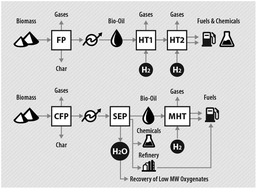Improving biomass pyrolysis economics by integrating vapor and liquid phase upgrading
Abstract
Partial deoxygenation of bio-oil by catalytic fast pyrolysis with subsequent coupling and hydrotreating can lead to improved economics and will aid commercial deployment of pyrolytic conversion of biomass technologies. Biomass pyrolysis efficiently depolymerizes and deconstructs solid plant matter into carbonaceous molecules that, upon catalytic upgrading, can be used for fuels and chemicals. Upgrading strategies include catalytic deoxygenation of the vapors before they are condensed (in situ and ex situ catalytic fast pyrolysis), or hydrotreating following condensation of the bio-oil. In general, deoxygenation carbon efficiencies, one of the most important cost drivers, are typically higher for hydrotreating when compared to catalytic fast pyrolysis alone. However, using catalytic fast pyrolysis as the primary conversion step can benefit the entire process chain by: (1) reducing the reactivity of the bio-oil, thereby mitigating issues with aging and transport and eliminating need for multi-stage hydroprocessing configurations; (2) producing a bio-oil that can be fractionated through distillation, which could lead to more efficient use of hydrogen during hydrotreating and facilitate integration in existing petroleum refineries; and (3) allowing for the separation of the aqueous phase. In this perspective, we investigate in detail a combination of these approaches, where some oxygen is removed during catalytic fast pyrolysis and the remainder removed by downstream hydrotreating, accompanied by carbon–carbon coupling reactions in either the vapor or liquid phase to maximize carbon efficiency toward value-driven products (e.g. fuels or chemicals). The economic impact of partial deoxygenation by catalytic fast pyrolysis will be explored in the context of an integrated two-stage process. Finally, improving the overall pyrolysis-based biorefinery economics by inclusion of production of high-value co-products will be examined.



 Please wait while we load your content...
Please wait while we load your content...